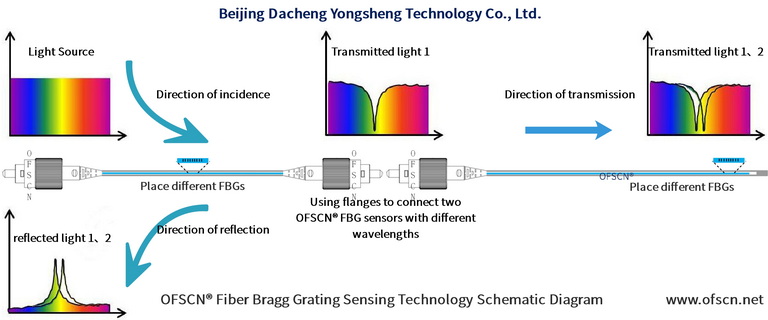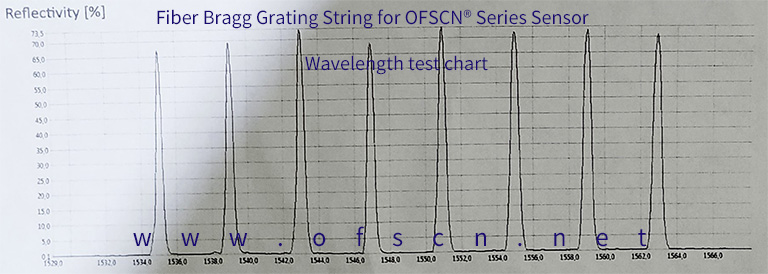This article analyzes the inherent drawbacks of fiber Bragg gratings (FBGs), which pose technical challenges in the packaging of fiber Bragg grating sensors (FBG sensors). It also introduces the accurate fiber Bragg grating temperature sensor (Bragg fiber grating thermometer) and proposes temperature compensation solutions for fiber Bragg grating stress sensors and fiber Bragg grating strain sensors developed by DCYS. The article also mentions fiber Bragg grating strings/arrays (FBGs) and serial fiber Bragg grating sensors with FBGs (serial FBG sensors ).
In the previous article, "Basic Principles of Fiber Bragg Gratings and Fiber Bragg Grating Sensors - Part 2: FBG Sensing Principles," we learned that fiber Bragg gratings (FBGs) can directly measure fundamental physical quantities such as stress, strain, and temperature. This direct measurement is possible because the grating period (grating pitch) of FBGs is directly related to three basic physical parameters: force (tensile or compressive force), length (elongation or contraction), and temperature (heating or cooling). Among these changes, force and temperature variations are considered causes, while length changes are considered results (as shown in Figure 1).
 |
|
Figure 1 |
The conclusions mentioned above form the theoretical basis for sensing with fiber Bragg gratings (FBGs) and fiber Bragg grating sensors (FBG sensors). However, they also present a new challenge or technical difficulty, which is the inherent drawback of fiber Bragg gratings.
1. Drawbacks of Fiber Bragg Gratings (FBGs) and Packaging Challenges of Fiber Bragg Grating Sensors (FBG Sensors)
The problem we face is that when using a fiber Bragg grating (FBG) and a fiber Bragg grating sensor (FBG sensor) for sensing and detection, we observe a change in the reflected wavelength (corresponding to the change in grating pitch). The challenge lies in determining whether this change is caused by force variations or temperature variations.
Unless this issue is addressed, it is impossible to determine the type of fiber Bragg grating sensor being used (fiber Bragg grating temperature sensor, fiber Bragg grating stress sensor, or fiber Bragg grating strain sensor). Furthermore, it is difficult to ensure the accuracy of the measurements obtained from fiber Bragg grating sensors.
2. Start with an Accurate Fiber Bragg Grating Temperature Sensor
In this remarkable era, DCYS has been fortunate to stand on the shoulders of giants in multiple industries and has creatively combined the modern metallurgical pipe manufacturing industry with the fiber Bragg grating sensing industry. As a result, we have developed our own solution to address the challenge of separating temperature and stress/strain in fiber Bragg gratings (FBGs) and fiber Bragg grating sensors (FBG sensors). This solution has led to the creation of the OFSCN® capillary Seamless Steel Tube Fiber Bragg Grating Sensor series (refer to Figures 2 and 3 for the packaging structure of the fiber Bragg grating sensor).
 |
|
Figure 2 |
 |
|
Figure 3 |
Figure 2 shows the OFSCN® capillary Seamless Steel Tube Fiber Bragg Grating Temperature Sensor (Type 01). We can confidently state that this fiber Bragg grating temperature sensor perfectly achieves the separation of temperature and stress/strain, both in principle and in practical measurements. We will provide further details and experimental evidence in subsequent articles.
This product also offers high sensitivity, fast heat conduction, excellent accuracy, compact size, light weight, high tensile and compressive strength, high temperature resistance, corrosion resistance, water and moisture resistance, non-combustibility, and other characteristics. It is an innovative Bragg fiber grating temperature sensor. With this product, we hope that DCYS can help advance the entire fiber Bragg grating sensing industry and contribute to its further development.
3. Temperature Compensation Principles for Fiber Bragg Grating Stress Sensors and Fiber Bragg Grating Strain Sensors
Figure 3 shows the OFSCN® capillary Seamless Steel Tube Fiber Bragg Grating Stress/Strain Sensor (Type 02). Although this product does not achieve temperature and stress/strain separation independently, it can be used in conjunction with the OFSCN® capillary Seamless Steel Tube Fiber Bragg Grating Temperature Sensor (Type 01) to address the challenge of temperature and stress/strain separation, as depicted in Figure 4.
 |
|
Figure 4 |
4. Concept of Fiber Bragg Grating Strings/Arrays (FBGs) and Serial Fiber Bragg Grating Sensors (FBG Sensors with FBGs)
To better understand the previous diagram, let's first supplement some basic knowledge about fiber Bragg gratings (FBGs). One of the flexible features of fiber Bragg grating sensors is the ability to achieve multipoint sensing. In theory, we can inscribe numerous FBGs with different wavelengths in a single sensor, enabling distributed detection of one or multiple physical parameters (corresponding to the OFSCN® Capillary Seamless Steel Tube Distributed Fiber Bragg Grating Sensor).
For a specific example, refer to Figure 5, which illustrates a fiber with nine FBGs of different wavelengths. This setup allows simultaneous measurement at nine different points.
 |
|
Figure 5 |
 |
|
Figure 6 Figure 6 displays the wavelength distribution of an eight-channel fiber Bragg grating array (FBGs) on an optical spectrum analyzer. |
5. Temperature Compensation for Fiber Bragg Grating Sensors
Returning to the example in Figure 4, we use two OFSCN® Capillary Seamless Steel Tube Fiber Bragg Grating Sensors, Sensor 1 and Sensor 2, with different wavelengths. Sensor 1 is sensitive to both temperature and stress/strain, while Sensor 2 is only sensitive to temperature. They are placed in the same environment, with the same temperature. For Sensor 1, the change in wavelength includes the influence of both temperature and stress/strain. However, we already know its temperature accurately (from Sensor 2), so we can subtract the temperature's impact on the wavelength change, leaving only the effect of stress/strain (calculation details can be found in the formula: ΔλB =λB(1-Pe)Δε+λB(αf-ξ)ΔT).
In this sensor configuration, Sensor 1 becomes an accurately calibrated fiber Bragg grating stress sensor and fiber Bragg grating strain sensor (this calculation process is known as temperature compensation for fiber Bragg grating sensors).
The OFSCN® Capillary Seamless Steel Tube Fiber Bragg Grating Temperature Sensor can also be used for temperature compensation in other applications, such as fiber Bragg grating vibration sensors, fiber Bragg grating shape sensors, fiber Bragg grating gas sensors, and fiber Bragg grating pressure sensors.
Based on the above discussion, the OFSCN® Capillary Seamless Steel Tube Fiber Bragg Grating Sensors produced by DCYS successfully achieve the separation of temperature and stress/strain, overcoming the inherent drawbacks of fiber Bragg gratings. The key lies in the fact that the OFSCN® Capillary Seamless Steel Tube Fiber Bragg Grating Temperature Sensor provides accurate temperature measurement unaffected by stress/strain. How does DCYS achieve this? The principles and mysteries will be revealed in the next article. Stay tuned!
Our philosophy is: "OFSCN®, make optical fiber stronger!"
